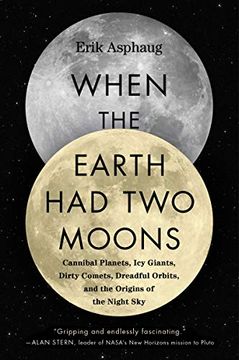Compartir
When the Earth had two Moons: Cannibal Planets, icy Giants, Dirty Comets, Dreadful Orbits, and the Origins of the Night sky (en Inglés)
Erik Asphaug (Autor)
·
Custom House
· Tapa Blanda
When the Earth had two Moons: Cannibal Planets, icy Giants, Dirty Comets, Dreadful Orbits, and the Origins of the Night sky (en Inglés) - Erik Asphaug
$ 34.220
$ 57.033
Ahorras: $ 22.813
Elige la lista en la que quieres agregar tu producto o crea una nueva lista
✓ Producto agregado correctamente a la lista de deseos.
Ir a Mis Listas
Origen: Estados Unidos
(Costos de importación incluídos en el precio)
Se enviará desde nuestra bodega entre el
Martes 18 de Junio y el
Martes 02 de Julio.
Lo recibirás en cualquier lugar de Argentina entre 1 y 3 días hábiles luego del envío.
Reseña del libro "When the Earth had two Moons: Cannibal Planets, icy Giants, Dirty Comets, Dreadful Orbits, and the Origins of the Night sky (en Inglés)"
An astonishing exploration of planet formation and the origins of life by one of the world’s most innovative planetary geologists.In 1959, the Soviet probe Luna 3 took the first photos of the far side of the moon. Even in their poor resolution, the images stunned scientists: the far side is an enormous mountainous expanse, not the vast lava-plains seen from Earth. Subsequent missions have confirmed this in much greater detail.How could this be, and what might it tell us about our own place in the universe? As it turns out, quite a lot.Fourteen billion years ago, the universe exploded into being, creating galaxies and stars. Planets formed out of the leftover dust and gas that coalesced into larger and larger bodies orbiting around each star. In a sort of heavenly survival of the fittest, planetary bodies smashed into each other until solar systems emerged. Curiously, instead of being relatively similar in terms of composition, the planets in our solar system, and the comets, asteroids, satellites and rings, are bewitchingly distinct. So, too, the halves of our moon.In When the Earth Had Two Moons, esteemed planetary geologist Erik Asphaug takes us on an exhilarating tour through the farthest reaches of time and our galaxy to find out why. Beautifully written and provocatively argued, When the Earth Had Two Moons is not only a mind-blowing astronomical tour but a profound inquiry into the nature of life here―and billions of miles from home.

